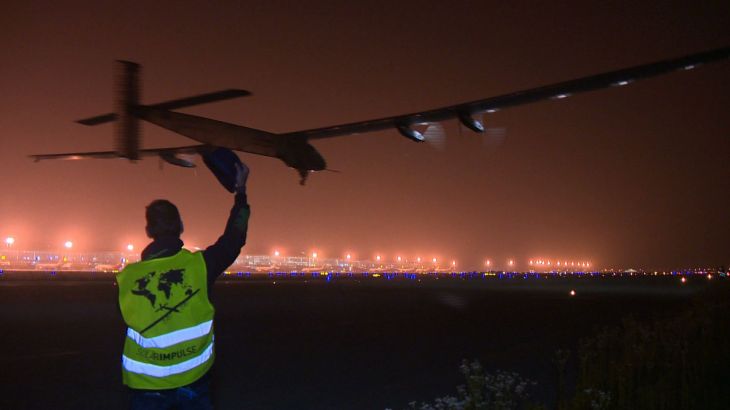Solar plane starts ‘risky’ Pacific crossing
Solar Impulse 2 is attempting to fly 8,000km from Nanjing to Hawaii in an extreme test of endurance and new technology.

Solar Impulse 2, an experimental solar-powered aircraft, has taken off from the eastern Chinese city of Nanjing for Hawaii on a leg described as “risky” by the project’s managing director.
“We can predict weather two or three days out fairly accurately,” Gregory Blatt told Al Jazeera on Sunday.
Keep reading
list of 4 itemsPalestinian life under Israeli occupation: An illustrated guideThis article will be opened in a new browser window
Boeing’s jets turn 70: A timeline of highs, lows and turbulence
US university ties to weapons contractors under scrutiny amid war in Gaza
“But predicting five days out is very, very difficult. Crossing the Pacific there are no alternate airports [if we encountered problems]. That’s what keeps me up at night, that’s what keeps up the teams, the engineers and the pilots.”
The plane, which has a wing span wider than a jumbo jet but weighs little more than a car, started its round-the-world flight on March 9 in Abu Dhabi.
Since then it has flown more than 7,200km powered exclusively by 17,000 solar cells on its wings. It made six stop-overs en route and set two world records.
On its flight from Muscat to Ahmedabad it set the world record for the longest single manned solar-powered flight (1,468km). On a subsequent leg between Varanasi and Mandalay it set the record for the fastest manned solar-powered flight with a maximum groundspeed of 216 km/h.
Solar Impulse 2 has been designed to fly on three engines if one fails. It can also share the electricity in its batteries between engines.
The flight across the Pacific, almost exclusively over ocean, had been expected to take five days. Now, due to a change in weather patterns it is expected to take six, or even seven days.
This will make it the longest and most dangerous leg so far.
“If we have to ditch for whatever reason the pilot will have to separate himself from the airplane,” says Blatt.
“Obviously an electrical airplane in water is not a great combination, so the pilot is equipped with a parachute, a life-vest and with emergency equipment.”
For the craft’s highly experienced solo pilot André Borschberg, 62, it will also be a feat of endurance. He will be only be able to sleep for 20 minutes at a time in the plane’s tiny cockpit.
The aircraft will climb to an altitude of 8,500m (28,000ft) each day, to expose its solar cells to the brightest sunlight.
“The cabin is not pressurised,” said Blatt. “The pilot wears an oxygen mask. We have five oxygen systems, redundancies in case one breaks down. Keeping the pilot breathing is a very, very big challenge.”
Rather than being any kind of showcase for the future for aviation, the Solar Impulse project hopes its journey around the world using just the energy of the Sun will demonstrate how new technology can be used.
“This is a risky project and in particular this leg is risky,” said Blatt. “But if it works then we are showing the humongous potential of these new technologies.”